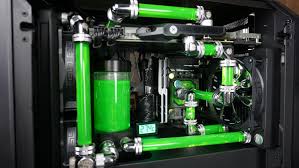We needed someone to compete against AMD’s stronghold on the CPU market, and it looks like Intel’s stepped up to the plate.
Niam Radia from the GamerTech Team | November 8th, 2021
What’s new?
Intel has been falling behind while their competitor, AMD has been bulldozing ahead releasing new Ryzen processors that outperform their counterparts. However, that all changed when Intel released their new 12th generation processors with a new trick up their sleeve to push past AMD. All consumer-desktop CPUs until now have a pretty standard design, they generally have anywhere from four to sixteen high-performance cores (P-cores) that are multithreaded (each core has two threads). With Intel’s 12th gen, they’ve changed the core layout in a way that mimics what Apple has just done in their Mac lineup. Now, there are two types of cores on the chip that increase both performance and efficiency. First, there are anywhere from six to eight “high-performance” cores based on the new Golden Cove architecture. These cores are based on the new Intel 7 process with many more improvements, the biggest being anywhere from a 10-20% performance uplift over their previous generation processors. Next, there are anywhere from four to eight efficiency cores (E-cores) on the new Gracemont architecture, which is similar to lower-powered Intel 6th gen Skylake cores. These cores are great for lighter tasks that are still heavily multithreaded and can also handle any background tasks, allowing the P-cores to focus on the intensive tasks. Having these two types of cores allows for the performance cores to just do their job, perform, leaving any background or multithreaded tasks to the help of the E-cores.
New technologies
With a new CPU architecture comes many new technological changes and improvements. A lot of them are smaller upgrades but some things are nice for a new platform that will be around for quite a while. First, Intel has created a new “Thread Director” that interacts with the operating system and tells the OS which cores to give the work to. Currently, it’s only supported on Windows 11, however, it helps to improve the performance of these CPUs and push it past its competition. Second, the new generation brings a new chip size, a new socket, and a new chipset. The 12th gen CPUs have to be bigger to account for both core types, which is why they’ve gotten rid of the LGA1200 socket and are now on LGA1700 with almost a 50% size increase. This means that you’ll need a new LGA1700 motherboard with the Z690 chipset. This new chipset brings several new features. First is support for DDR5 memory. It isn’t interchangeable with DDR4, but the new memory generation brings much higher speeds. There are also 16 PCIe 5.0 lanes which future-proofs this system for future graphics cards. Integrated WiFi 6E support and Thunderbolt 4 are also nice to have. All of these technological advancements help Intel push their processors forward and are also helping bring other technologies into the future.
How does the Core i9-12900k perform?
The biggest and most important question is, how do they perform? The short answer, absolutely amazing, the long answer, really good. If you just look solely at its performance numbers, the flagship Core i9-12900k is a super-fast CPU. In Cinebench R23, a common CPU benchmarking test the 12900k with DDR5 memory beats out its AMD counterparts. In the multithreaded test, the new chip is 21% faster than the 12-core Ryzen 9 5900x, and 7% faster than the 16-core Ryzen 9 5950x! The i9 is also 17% faster in the single-threaded test compared to the 5th gen Ryzen 9’s and the i9-11900k (the previous-gen Intel flagship). This shows that we don’t just see almost a 20% IPC improvement across the new generation, but this also shows that the efficiency cores are a lot more powerful than we thought and can keep up with the full-powered cores on the AMD processors. Gaming performance is a bit more difficult to measure right now, as the 12th gen chips are only properly optimized for Windows 11, while AMD CPUs don’t like the new version of Windows right now. In early gaming benchmarks, we’re seeing anywhere from a 2-15% improvement over other high-end CPUs (5th gen Ryzen and 11th gen Intel) depending on the game. These are great, especially because the 11th gen Intel CPUs performed similarly to Ryzen’s 5th gen, and this small improvement helps to push Intel’s chips ahead of AMD.
Should you buy it?
If we look at the Intel Core i9-12900k, Intel’s new flagship processor, there are many good reasons to buy this CPU. There are many new technological features, better power efficiency, and of course a large improvement to its performance which makes this new chip compelling. However, there are still many reasons why you’d want to purchase an AMD CPU. First, the 12900k slots right in between the Ryzen 9 5900x and 5950x price-wise. It is faster than the 5900x but slower in some productivity tasks compared to the 5950x, but you also have to consider the price. You may get up to a 20% improvement over the 5900x, but you’re paying 13% more for just the chip alone. You also have to account for the more expensive and hard-to-find Z690 motherboards, and if you choose to go DDR5, the insanely high pricing on those new modules makes the platform a lot more expensive. If you’re on a tighter budget or if you’re only really using the chip for productivity, the AMD Ryzen 9 5900x or 5950x may be a better bet. But, if you’re doing a lot of gaming and using other applications, or if you have a larger, more loose budget, the Intel Core i9-12900k is a great option.
What about the other 12th gen CPUs?
The newly launched Core i5-12600k and Core i7-12700k are both extremely solid CPUs. They both have similar single-core improvement just like their bigger brother, and on the multi-core side, these efficiency cores are really putting in some work. The problem with these chips right now is the overall platform price. Currently, the lower-tier B660 boards haven’t been released yet, meaning you have to spring for a high-end, expensive Z690 board. In some cases, these new motherboards are more expensive than the CPU itself! Again, if money isn’t much of an issue, then these new chips are amazing, however, at least for the near future, AMD’s lower-end CPUs may be a better option for price-to-performance.
------------------------------------------



